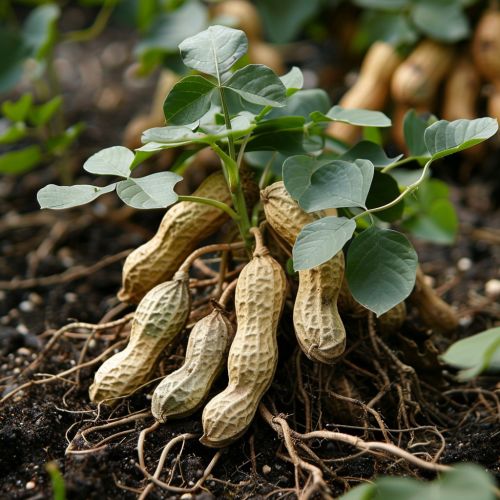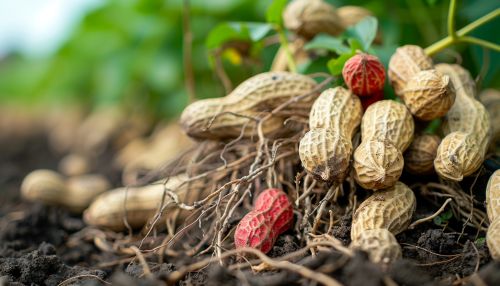Arachis hypogaea
Introduction
Arachis hypogaea, commonly known as the peanut, groundnut, or goober, is a legume crop grown mainly for its edible seeds. It is widely cultivated in tropical and subtropical regions, being a significant source of oil and protein. The plant belongs to the family Fabaceae and is native to South America.
Taxonomy and Nomenclature
The scientific classification of Arachis hypogaea is as follows:
- Kingdom: Plantae
- Clade: Angiosperms
- Clade: Eudicots
- Clade: Rosids
- Order: Fabales
- Family: Fabaceae
- Genus: Arachis
- Species: A. hypogaea
The genus Arachis includes several species, but A. hypogaea is the most economically important. The species name "hypogaea" derives from Greek, meaning "under the earth," referring to the unique characteristic of the plant's fruit development underground.
Botanical Description
Arachis hypogaea is an annual herbaceous plant growing to a height of 30-50 cm. The plant has a well-developed taproot system with lateral roots. The stems are erect or prostrate, and the leaves are pinnate with four leaflets.
Flowers
The flowers are small, yellow, and papilionaceous, typical of the Fabaceae family. They are borne in axillary clusters and are self-pollinating. After fertilization, the flower stalk elongates and bends downwards, pushing the developing fruit into the soil, a process known as geocarpy.
Fruit and Seeds
The fruit is a pod, typically containing 1-4 seeds. The pods are indehiscent, meaning they do not split open at maturity. The seeds, commonly known as peanuts, are encased in a thin, papery seed coat and are rich in oil and protein.


Cultivation
Arachis hypogaea is cultivated in a variety of soil types but prefers well-drained sandy loams. The plant requires a warm growing season of 120-150 days with a minimum temperature of 20°C for optimal growth.
Soil and Climate
Peanuts thrive in regions with a tropical or subtropical climate. They require a moderate amount of rainfall, ideally between 500-1000 mm annually. The soil should be well-drained and rich in organic matter.
Planting and Harvesting
Seeds are typically sown directly into the soil at a depth of 5-7 cm. The spacing between plants should be about 30-50 cm. Harvesting occurs when the leaves begin to yellow, and the pods have matured, usually 90-150 days after planting. The entire plant is uprooted, and the pods are separated from the plant.
Uses
Peanuts are versatile and have numerous uses in culinary, industrial, and agricultural sectors.
Culinary Uses
Peanuts are consumed in various forms, including roasted, boiled, and raw. They are used to make peanut butter, peanut oil, and various confectionery products. In many cultures, peanuts are a staple ingredient in traditional dishes.
Industrial Uses
Peanut oil is used in cooking and as a base for cosmetics and pharmaceuticals. The protein-rich meal left after oil extraction is used as animal feed.
Agricultural Uses
Peanut plants improve soil fertility through nitrogen fixation. The plant residues can be used as green manure or fodder for livestock.
Nutritional Profile
Peanuts are a rich source of protein, fats, and essential nutrients. They contain high levels of monounsaturated and polyunsaturated fats, which are beneficial for heart health. Peanuts are also rich in vitamins E and B-complex, as well as minerals such as magnesium, phosphorus, and potassium.
Health Benefits
Consuming peanuts has been associated with various health benefits, including improved heart health, weight management, and reduced risk of certain cancers. The high antioxidant content in peanuts, such as resveratrol, contributes to their health-promoting properties.
Economic Importance
Peanuts are a significant cash crop in many developing countries. They provide income for smallholder farmers and are a crucial component of food security. Major peanut-producing countries include China, India, Nigeria, and the United States.
Challenges in Cultivation
Peanut cultivation faces several challenges, including susceptibility to diseases such as Aspergillus flavus infection, which produces aflatoxins. Pests like the peanut root-knot nematode and the peanut beetle also pose significant threats. Climate change and water scarcity further complicate peanut farming.
Research and Development
Ongoing research aims to improve peanut yield, disease resistance, and nutritional quality. Genetic engineering and traditional breeding techniques are employed to develop new peanut varieties with enhanced traits.
